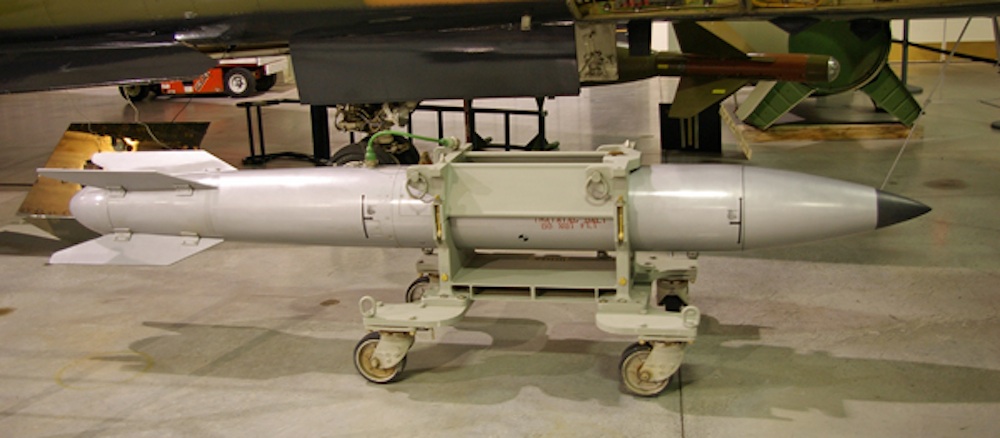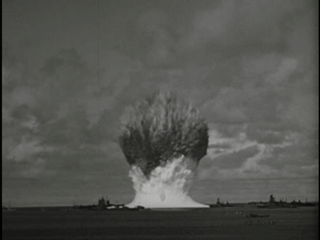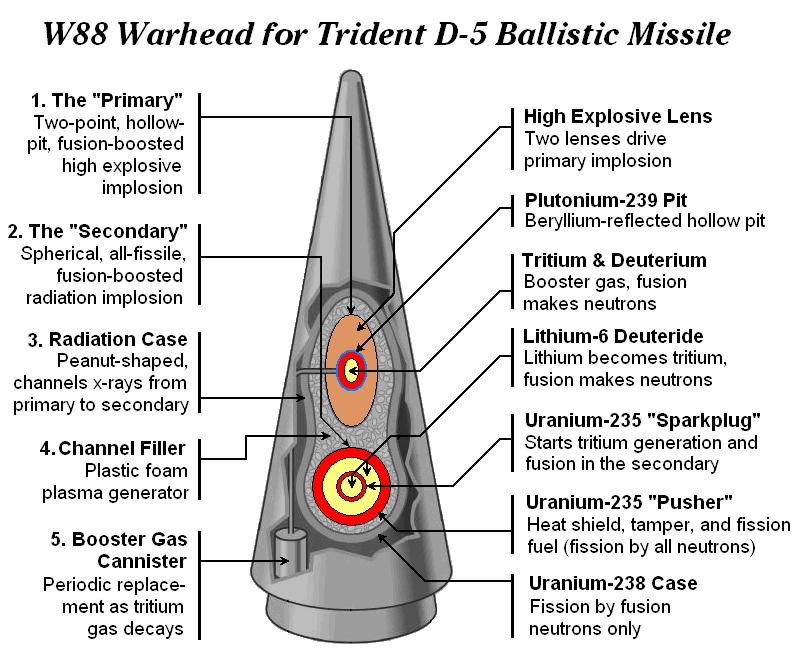June 04, 2014
We are now Able to Announce an Increase From 340 to 50
It's that new math!



Comments are disabled.
No we're not talking about the chocolate ration. We're talking about the B-61 nuclear bomb. This is a fearsome weapon having a yield that can be varied between the equivalent of 300 tons and 340 kilotons of TNT.

Having first been tested in 1966, the B-61 one of the only two atomic bombs the US possesses and is, by a wide margin, the oldest atomic weapon in the U.S. arsenal. As such these weapons are in need of refurbishment or replacement. The current administration scrapped plans for the reliable replacement warhead on the grounds that developing a new weapon was not in the spirit of nuclear disarmament. However, the aged B-61 (the design of which actually began in 1960) was becoming a concern for reliability (and safety) reasons so something had to be done.
The result was the B-61-12, an program to refurbish and upgrade the bombs. This has caused some consternation on the left as the addition of a GPS guidance package to the bomb, which gives it an accuracy equivalent to the most modern 'smart' conventional warheads is considered by many to be adding a new capability and a possible treaty violation. Given that the "new capability" is simply a greatly increased probability of hitting its target this does not seem to be a particularly meritorious argument.
However, as part of the upgrade, the maximum yield of the weapons is being reduced to 50 kilotons, a tad over one seventh the current value.
Now 50 kilotons is a terrifying thing. For perspective, see what a 21 kiloton blast detonated 90 feet below the surface of the water can do.

For scale, that black stain on the lower right of the cauliflower of death is BB33, USS Arkansas...the only US battleship to fly.
Still, you're reducing the yield to a tad over one seventh of it's current yield. The rationale may be that the weapon's accuracy would allow in some situations a lower yield setting to be used, thus reducing the blast area to obliterate a target and, in the unfortunate scenario where a ground burst is necessary, reducing fallout significantly. That is all well and good, but...
...except in a few very specific, oddball scenarios, if we are forced to use these terrible weapons, collateral damage damage is not going to be a concern.
Nukes are for deterrence.
That means that if we, God forbid, have to use these dreadful devices, we're going to come at whoever pushed us that far like the bastard children of an affair between Andrew Jackson, William T. Sherman and Curtis Lemay. The reason to have these weapons is the implication that we will UTTERLY DESTROY any country that attacked us with nukes or comparable weapons. To that end reducing the yield does not seem wise. It removes an option for greater power if needed and in doing so increases the likelihood that some blinkered individual will conclude that they can "take the hit" and absorb our retaliatory strike.
On the face of it, that's crazy, but if one (for instance) has expressed the opinion that Mao was a man to be admired and that the 'Great Leap Forward' and Cultural Revelation' were noble endeavors...then one might be the sort of psychopath who sees China's billion or so people as "spares". The rather large reduction in yield per bomb might well reinforce that dubious notion.
Now there may be a technical reason for the reduced yield. If the guidance package displaces, say, a tritium tank and 50KT is all they can manage then the increased accuracy is probably a good trade off. But unnecessarily reducing the yield of our weapons so dramatically, when we are already substantially reducing the numbers of our weapons seems imprudent at best.
So...one might wonder "What about the other nukes?"
Well, here's what's left.
B-61: Has already been mentioned. The most common nuclear bomb in the arsenal and second most common nuke in the US Inventory. Also used (with US controlled activation keys) by Germany, Italy and Turkey.
B-83: Designed 20 years after the B-61 it is a very advanced free-fall atomic bomb and has every available safety feature. It is also variable yield 20KT to 1.2 MEGAtons. (1200 kilotons) . By far the most powerful weapon remaining in the arsenal after the scrapping of the B-53s in 2011 . The last US atomic weapon fully tested to full yield. It is neither a reliability nor a safety concern. About 650 were manufactured most of which are still in storage.
W-76: a US/UK SLBM warhead with a yield of 100KT. By far the most common warhead in the US arsenal. Publicly available documents indicate that there have always been some concerns regards this aging weapons reliability. It is currently the subject of a refurbishment program which made the alarming discovery that the technique for making an important component of this weapon had been lost. Reportedly a work around has been developed after 9 years of intense research..It is hoped to have these 30+year old warheads refurbished by 2018. Though doubts about the basic design's reliability may remain.
W-78: The surviving Minuteman 3 missiles were designed to carry three of these 300 KT weapons apiece. There are concerns about its safety and age thus it is being rapidly phased out in favor of 1 W-87 for every 3 W-78s.
W-80: 150 KT This is the warhead on the Air-Force's cruise missiles. It was also used on the nuclear version of the Navy's Tomahawk, which has since been retired.
W-87: 300 KT Originally built for the Peacekeeper missile which could cary 10 apiece, the treaty mandated retirement of those 50 missiles freed up about 500 of these and they are being distributed amongst the 450 surviving Minuteman 3 missiles. This cuts the number of ICBM warheads by a third but improves safety and reliability of the warheads. There was an upgrade proposal to raise its yield to 475KT but this does not seem to have been done.
W-88: Thought to be, in many ways, a much more advanced design than the Air-Force's W-87, this roughly 475KT warhead is the preferred warhead for the Trident 2 SLBM which can cary 14 of them. However, the Trident is limited by treaty to 8. This weapon is considered to be by far the most advanced US nuclear warhead, more than quadrupling the yield of the similarly sized W-76. This weapon was to replace all of those older warheads but production was shut down at only 400 after the EPA/FBI raid on the Rocky Flats production facility in 1989. Although it was intended to restart production in the early 90s it was not resumed...in the US.
However, in 1995 the FBI discovered that China had obtained plans for the W88, and this diagram, which apparently contained all sorts of confidential details appeared in the NYT.

No new nukes have been made in the US since the end of the Cold War. The deterrent is aging and shrinking.
It seems inadvisable to shrink it more than necessary...especially when the Russians and Chinese are modernizing and in the case of the Chinese, expanding and brandishing theirs.
Posted by: The Brickmuppet at
08:11 AM
| No Comments
| Add Comment
Post contains 1206 words, total size 11 kb.
31kb generated in CPU 0.0184, elapsed 0.0927 seconds.
66 queries taking 0.0822 seconds, 209 records returned.
Powered by Minx 1.1.6c-pink.
66 queries taking 0.0822 seconds, 209 records returned.
Powered by Minx 1.1.6c-pink.









